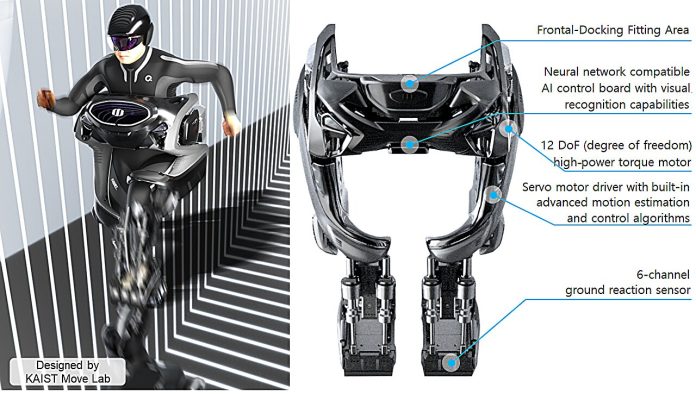
Researchers at the Korea Advanced Institute of Science and Technology (KAIST) have introduced a groundbreaking wearable robot called the WalkON Suit F1.
This innovative device allows people with complete paralysis to put it on without leaving their wheelchair or needing help from others.
The robot is designed to walk to the user, making it easier for them to “suit up” and regain mobility. This exciting advancement aims to empower users to be more independent and improve their quality of life.
The WalkON Suit F1 was developed by a team led by Professor Kyoungchul Kong from KAIST’s Department of Mechanical Engineering.
The professor is also the CEO and founder of Angel Robotics.
His team has been working on this wearable robot since 2015, with a focus on helping those with the most severe type of paraplegia, known as American Spinal Injury Association (ASIA) Impairment Scale–A.
This level of injury results in complete paralysis.
Previous versions of the WalkON Suit were introduced in 2016 and 2020. By 2020, the WalkON Suit could help users walk at normal walking speeds of up to 3.2 km/h and navigate daily challenges like narrow passages, doors, and stairs.
However, users still needed assistance to put on the suit, which limited their independence.
The latest version, WalkON Suit F1, addresses this problem with a unique feature. Instead of requiring users to sit down and get help from others, the robot uses a new frontal-docking method. The suit can walk up to the user and be put on while they remain in their wheelchair. This method allows people to be more self-sufficient and eliminates the need for mid-transition assistance.
The WalkON Suit F1 features a sleek design that combines elements of both a humanoid robot and a wearable suit. It was developed in collaboration with Professor Hyunjoon Park from KAIST’s Department of Industrial Design. The design not only looks futuristic but is also practical for maintaining balance and stability.
The robot includes advanced balance control features, allowing users to freely use both hands while standing. This improvement means users can take several steps without relying on a cane for support. Additionally, the robot’s enhanced weight distribution and balance controls prevent it from tipping over, even if the user accidentally pushes it.
The technological advancements in this latest version are impressive. Through collaboration with Angel Robotics, the team achieved improvements in all key components, such as the motor, motor driver, reducer, and main circuit. The power output of the motor and reducer modules has doubled compared to previous versions, and the motor driver’s control speed is now three times faster than leading overseas technologies. The embedded software has also been upgraded to handle advanced motion control without requiring expensive high-end controllers.
The KAIST research team is set to showcase the WalkON Suit F1 at the upcoming 3rd Cybathlon, an international competition for advanced wearable robotics, also known as the “Cyborg Olympics.” The Cybathlon is held every four years in Switzerland, and the 2020 event saw Professor Kong’s team win a gold medal. This year, the event will be hybrid, with some participants competing in Switzerland and others live-streaming their performances from their home countries.
The KAIST team will compete from Angel Robotics’ Advanced Research Institute, known as “Planet Daejeon.” The team leader, Ph.D. student Jeongsu Park, expressed confidence in their ability to demonstrate the technological advancements of the WalkON Suit F1. “We aim to show the technological gap rather than competing for rankings,” Park said.
While the competition’s difficulty level has increased, with the number of missions growing from six to ten, the team is eager to prove their robot’s capabilities.
The WalkON Suit F1 is a testament to the progress being made in wearable robotics for people with severe disabilities.
Professor Kong emphasized that the advancements made in the WalkON Suit F1 set new standards for the wearable robot industry and could inspire future innovations. With continued research and improvements, wearable robots like the WalkON Suit F1 have the potential to transform the lives of people with mobility challenges, giving them greater independence and freedom.



